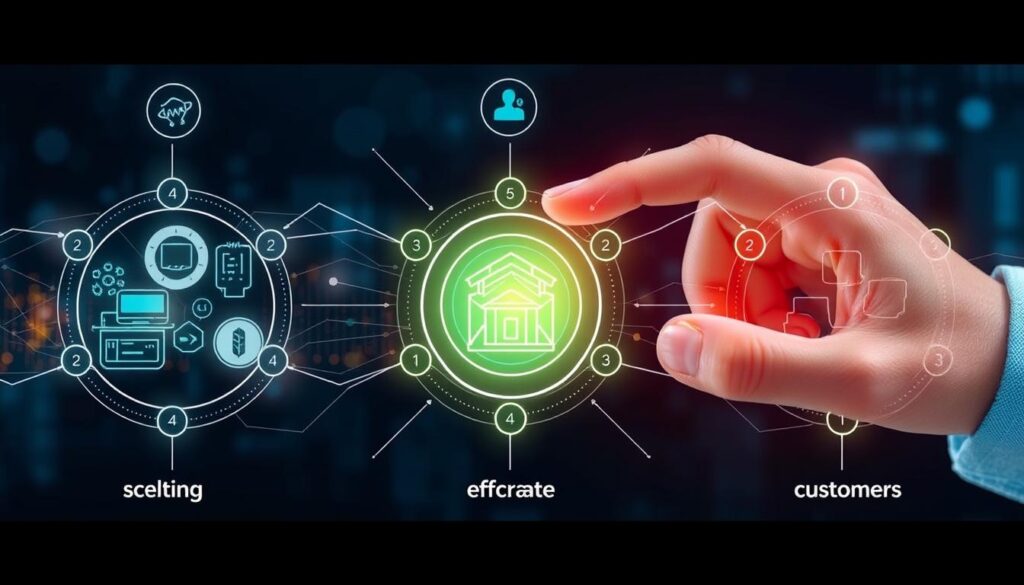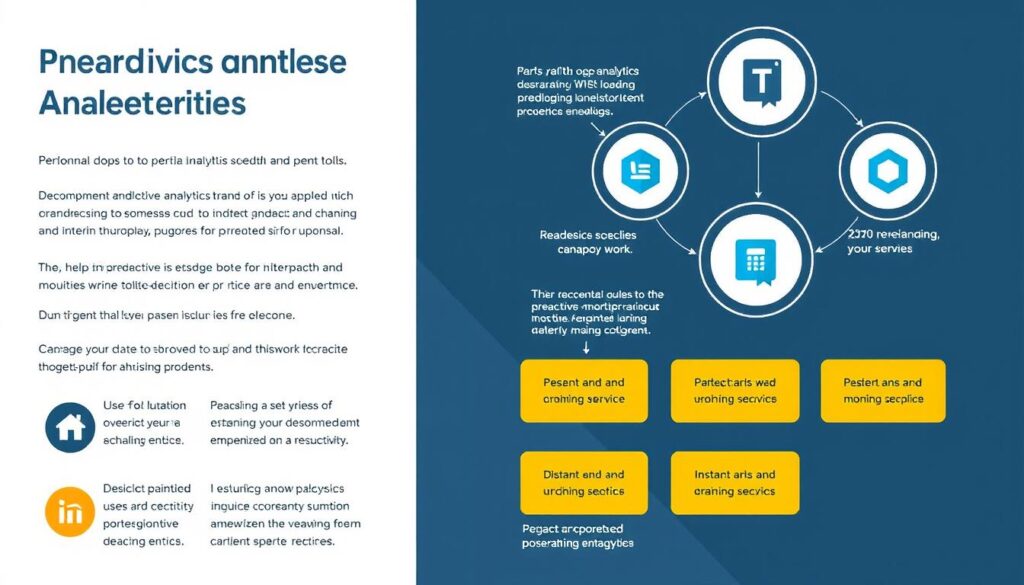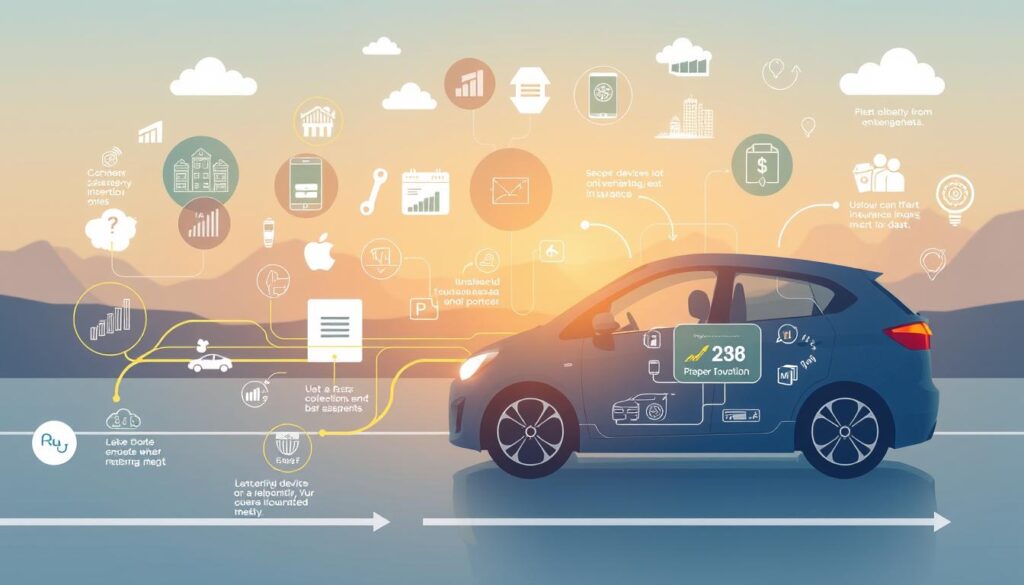The insurance landscape is undergoing a significant transformation. As we step into 2024, a wave of technological innovation is reshaping this age-old sector. 82% of insurance companies implementing LCNC tools report increased operational efficiency, according to Capgemini.
We’re witnessing an unprecedented transformation in the insurance industry as new technologies revolutionize traditional processes and create new opportunities for growth and efficiency. The digital revolution is fundamentally changing how insurers assess risk and engage with customers.
At CoWrit Technologies Inc, we’re at the forefront of helping insurance companies navigate this technological transformation through our comprehensive services, including AI Generative Applications and Digital Marketing solutions.
Key Takeaways
- The insurance sector is being transformed by technological innovations.
- Insurers are leveraging data to make informed decisions.
- Customer engagement is being redefined through digital channels.
- Technological adoption is crucial for insurers to remain competitive.
- New technologies are streamlining operations and enhancing customer experiences.
The Digital Revolution in Insurance
The insurance industry is undergoing a significant transformation driven by technological advancements. This shift is not just about adopting new technologies; it’s about reimagining the very fabric of the insurance business to better serve customers, mitigate risks, and stay ahead in a competitive landscape.
Current State of Technology Adoption
The current state of technology adoption in the insurance industry is characterized by a mix of legacy systems and innovative solutions. Insurers are increasingly leveraging technologies like artificial intelligence (AI), Internet of Things (IoT), and blockchain to enhance their operations and customer engagement. While there’s a notable variance in the level of technology adoption across different insurers, the overall trend is towards greater digitalization.
Key Drivers of Technological Transformation
Several key drivers are pushing the insurance industry toward technological transformation. Productivity enhancements, cost savings, and new revenue generation are among the top reasons insurers are adopting new technologies. The increasing frequency and severity of global risks, such as climate change and cybercrime, are also compelling insurers to enhance their risk management capabilities through technology.
- Customer expectations are evolving, with a growing demand for digital convenience and personalized insurance products.
- Competitive pressure is intensifying as insurtechs and tech-savvy traditional insurers raise the bar for digital capabilities.
- Regulatory changes are creating both challenges and opportunities for insurers to leverage technology for compliance and efficiency.
By embracing these technological trends, insurers can not only improve their operational efficiency but also develop innovative products and services that meet the changing needs of their customers.
Artificial Intelligence: The Cornerstone of Insurance Innovation

The insurance industry is undergoing a significant transformation, driven by the integration of artificial intelligence (AI) into its core processes. We’re seeing a paradigm shift in how insurers operate, from underwriting and risk assessment to customer service and claims processing.
Generative AI Applications in Insurance
Generative AI is opening new avenues for insurers to enhance their services and improve operational efficiency. By analyzing vast amounts of data, generative AI can help create personalized insurance policies tailored to individual customer needs.
For instance, generative models can be used to simulate various risk scenarios, enabling insurers to better understand potential risks and develop more effective mitigation strategies.
Machine Learning for Risk Assessment and Fraud Detection
Machine learning algorithms are revolutionizing risk assessment and fraud detection in the insurance industry. By analyzing patterns and anomalies in claims data, ML models can identify potential fraud, significantly reducing fraudulent claim payouts.
- We’ve seen machine learning revolutionize risk assessment in insurance by analyzing vast datasets to identify patterns and correlations that human underwriters might miss.
- Fraud detection has been dramatically improved through machine learning algorithms that can analyze patterns and anomalies in claims data, significantly reducing fraudulent payouts.
- We’re helping insurers implement predictive models that can assess risk with greater accuracy and granularity, leading to more precise pricing and improved loss ratios.
- Machine learning is enabling more personalized insurance offerings by analyzing customer data to identify specific risk factors and preferences.
By leveraging these AI-driven technologies, insurers can enhance their risk assessment capabilities, improve customer satisfaction, and maintain a competitive edge in the market.
Cutting-Edge Technology in Insurance Industry: Automation and Virtualization
The insurance industry is undergoing a significant transformation with the advent of cutting-edge technologies such as automation and virtualization. These innovations are not only enhancing operational efficiency but also revolutionizing the way insurers interact with their customers.
Digital Twins for Simulation and Risk Management
Digital twins, a technology that involves creating virtual replicas of physical assets or processes, are being increasingly adopted in the insurance industry. This technology allows insurers to simulate various scenarios, assess potential risks, and develop more effective risk management strategies. By leveraging digital twins, insurers can gain a deeper understanding of complex systems and make more informed decisions.
Some of the key benefits of digital twins in insurance include:
- Enhanced risk assessment capabilities through simulation
- Improved operational efficiency by identifying potential bottlenecks
- Better decision-making through data-driven insights

Intelligent Automation in Claims Processing
Intelligent automation is transforming the claims processing landscape in the insurance industry. By leveraging AI and IoT data analytics, insurers can automate tasks such as first notice of loss (FNOL) and claim resolution. This not only reduces cycle times but also improves accuracy and customer satisfaction.
The high-impact use cases of intelligent automation in claims processing include:
- Fully automated FNOL processes enabled by IoT data analytics
- Streamlined claim resolution through AI-powered solutions
- Improved customer experience through faster and more accurate claims processing
By embracing intelligent automation, insurers can reduce cycle times by up to 70% while enhancing customer satisfaction. It’s crucial for insurers to strike the right balance between technological efficiency and human empathy to achieve the most successful implementations.
Predictive Analytics: Revolutionizing Risk Management

Predictive analytics is revolutionizing the insurance sector by enhancing risk assessment and underwriting processes. According to Capgemini, streamlining underwriting with predictive analytics and smart devices is one of the top 10 trends in life and P&C insurance. This technological advancement is enabling insurers to make more informed decisions.
Advanced Risk Assessment Models
Predictive analytics algorithms assess risk profiles using hundreds of data points from internal and external sources. This creates a more comprehensive view of risk, allowing for more granular risk assessments. As a result, insurers can compete more effectively on price while maintaining profitability.
Advanced risk assessment models are transforming the insurance landscape. By leveraging cutting-edge technology, insurers can now assess risks with greater precision.
Data-Driven Underwriting Processes
We’re witnessing a fundamental shift toward data-driven underwriting processes, with predictive analytics playing a crucial role. This shift is helping insurers reach previously underinsured segments with more affordable products tailored to their specific risk profiles.
The integration of smart devices and IoT data into underwriting processes is providing real-time insights into risk factors that were previously difficult to assess. As technology trends continue to evolve, we believe the future of underwriting lies in the seamless integration of traditional actuarial expertise with cutting-edge analytics capabilities.
Enhancing Customer Experience Through Technology
As customer expectations evolve, insurers are leveraging technology to enhance their experience. The insurance industry is undergoing a significant transformation to become more customer-centric, driven by the need to adapt to changing customer expectations, technology, climate risks, and market dynamics.
AI-Powered Chatbots and Virtual Assistants
AI-powered chatbots and virtual assistants are revolutionizing customer service in the insurance industry. These technologies enable insurers to provide 24/7 support, helping customers with queries, claims, and policy purchases. By automating routine inquiries, insurers can free up human resources for more complex customer issues.
We’ve observed that AI-powered chatbots can significantly improve response times and customer satisfaction. For instance, a well-implemented chatbot can handle a large volume of customer inquiries simultaneously, reducing wait times and enhancing the overall customer experience.
Omnichannel Customer Engagement Strategies
Omnichannel customer engagement strategies are becoming essential for insurers to meet evolving customer expectations. Insurance customers typically interact with their carriers infrequently, making each touchpoint vital and requiring seamless transitions between digital and physical channels.
To achieve this, insurers are focusing on harmonizing customer journeys to ensure consistent experiences across different platforms. Successful omnichannel strategies require unified customer data platforms that aggregate information and make it accessible across the organization.

| Strategy | Description | Benefits |
|---|---|---|
| Unified Customer Data | Aggregating customer information across platforms | Enhanced customer insights, personalized experiences |
| Seamless Channel Transitions | Ensuring smooth interactions across digital and physical channels | Improved customer satisfaction, reduced friction |
| Consistent Customer Journeys | Harmonizing experiences across different touchpoints | Increased customer loyalty, better brand perception |
By implementing these strategies, insurers can significantly enhance customer experience, leading to better financial performance, including higher Total Shareholder Return (TSR), revenue growth, and employee satisfaction.
IoT and Telematics: Real-Time Data Revolution

We’re witnessing a significant transformation in the insurance sector, thanks to the advent of real-time data from IoT devices and telematics. This technological advancement is enabling insurers to reassess risks more accurately and offer more personalized insurance products.
The integration of IoT and telematics is providing a wealth of data, allowing for more precise underwriting and claims processing. This real-time data is revolutionizing the way insurers operate, making the insurance process more efficient and customer-centric.
Wearables and Smart Devices in Health Insurance
Wearables and smart devices are becoming increasingly popular in health insurance, allowing insurers to monitor policyholders’ health metrics in real-time. This data helps insurers to offer more tailored insurance plans and encourages policyholders to adopt healthier lifestyles.
By leveraging customer data from wearables and smart devices, insurers can better understand their clients’ needs and preferences, ultimately enhancing the overall customer experience.
Telematics for Usage-Based Auto Insurance
Telematics is transforming the auto insurance landscape through usage-based models that utilize real-time driving data to determine premiums. The global usage-based insurance market is expected to grow significantly, driven by the adoption of telematics technology.
Leading insurers like Tesla Insurance and GEICO’s DriveEasy are at the forefront of this trend, using sophisticated telematics to create more personalized auto insurance products. This approach not only benefits safer drivers with lower premiums but also promotes better driving habits overall.
Low-Code/No-Code Development for Insurance Applications

The insurance industry is on the cusp of a revolution with the adoption of low-code/no-code (LCNC) development platforms. These innovative tools are enabling insurers to rapidly develop and deploy applications, thereby enhancing their operational efficiency and customer engagement.
Democratizing Insurance Software Development
LCNC platforms are democratizing software development in the insurance sector by allowing business users to create applications without extensive coding knowledge. This shift is empowering insurers to respond more quickly to changing market conditions and customer needs.
With LCNC, insurers can develop a range of applications, including agent and customer self-service portals, underwriting automation tools, and real-time dashboards for monitoring claims and policy metrics. These applications not only improve operational efficiency but also enhance customer services and products.
Case Studies of Successful LCNC Implementation
Several insurance companies have successfully implemented LCNC platforms to drive innovation and efficiency. For instance, insurers have used LCNC tools to create customer-facing applications like claim intake apps and feedback tools, which have significantly improved customer engagement.
We’ve observed that LCNC implementations have enabled insurers to accelerate application development, reduce costs, and improve compliance with regulatory requirements. These case studies demonstrate the versatility and impact of LCNC tools in the insurance industry, allowing business users to create solutions that previously required specialized technical teams.
Cloud Computing: The Foundation of Insurance Technology

As the insurance industry continues to evolve, cloud computing has emerged as a foundational element in its technological transformation. The shift towards cloud solutions is enabling insurers to enhance their operational efficiency, improve data analysis, and provide better customer experiences.
Benefits of Cloud Migration for Insurers
Cloud migration offers numerous benefits to insurers, including scalability, flexibility, and cost savings. By leveraging cloud-based infrastructure, insurers can quickly adapt to changing market conditions and customer needs. Moreover, cloud computing facilitates the integration of advanced technologies like AI and analytics, driving business innovation.
The adoption of cloud solutions also enables insurers to streamline their operations, reduce IT costs, and improve data management. With cloud computing, insurers can focus on their core business activities while leaving the management of their IT infrastructure to cloud service providers.
Security and Compliance Considerations
As insurers migrate sensitive customer data and critical operations to the cloud, security and compliance considerations become increasingly important. Regulatory frameworks are evolving rapidly, with Colorado setting a high bar for AI governance in 2023 and the European Union making headlines with its comprehensive AI Act.
To address these concerns, insurers must implement robust security measures that protect customer data while enabling analytical capabilities. Compliance with industry-specific regulations, such as those from the National Association of Insurance Commissioners (NAIC), is essential when implementing cloud-based insurance technologies. Responsible and ethical use of cloud-based AI and analytics is critical not only for regulatory compliance but also for building and maintaining consumer trust.
We believe that addressing security and compliance considerations proactively is essential for insurers to realize the full benefits of cloud computing while mitigating associated risks. By doing so, insurers can ensure a successful cloud implementation that drives business value and supports their long-term goals.
Computer Vision and Image Recognition in Claims Processing
We’re witnessing a significant shift in how insurers handle claims, thanks to advancements in computer vision technology. This innovation is transforming the insurance industry by enhancing the efficiency and accuracy of claims processing.

Automated Damage Assessment
Computer vision enables insurers to automate damage assessment by analyzing images and videos of damaged properties or vehicles. This not only speeds up the claims process but also reduces the likelihood of human error. By leveraging computer vision solutions, insurers can assess damage more accurately and provide faster settlements to their customers.
The technology uses complex algorithms to identify and quantify damage, allowing for a more objective assessment. This data-driven approach helps insurers to process claims more efficiently and improve customer satisfaction.
Fraud Detection Through Visual Analysis
The rise of exaggerated claims following natural disasters has made fraud detection increasingly important for insurers. Computer vision technologies are being used to analyze images and videos for signs of manipulation or inconsistencies that might indicate fraudulent activity. By integrating visual analysis with predictive analytics, insurers can identify potential fraud more effectively.
Effective fraud detection requires the integration of multiple data sources, including claims history, fraud lists, and loss history. By combining these data sources with computer vision, insurers can create a robust fraud detection system that helps mitigate risk and reduce losses.
Emerging Business Models Enabled by Technology
Technology is revolutionizing the insurance sector by enabling innovative business models that cater to diverse customer needs. These new models are not only enhancing customer experience but also providing insurers with opportunities to tap into previously underserved markets.
Usage-Based Insurance and Pay-As-You-Go Policies
Usage-based insurance (UBI) and pay-as-you-go policies are gaining traction as they offer customers more flexibility and personalized coverage. These models use real-time data to adjust premiums based on the customer’s behavior, making insurance more fair and transparent. For instance, auto insurers can use telematics data to track driving habits and offer discounts to safe drivers.
Key benefits of UBI include:
- More accurate risk assessment
- Personalized premiums
- Incentives for safe behavior
Microinsurance and On-Demand Coverage Options
Microinsurance products are designed to cover low-income, underinsured segments by offering affordable plans tailored to specific customer needs. These products typically cover a single requirement for a particular period, such as event, crop, livestock, tech, theft, and travel insurance. On-demand coverage options allow customers to activate insurance protection only when needed, providing flexibility and convenience.

We’re seeing microinsurance emerge as an important technology-enabled business model, making insurance more accessible to previously underserved segments. These innovative products are designed to cover specific needs for particular periods, and their growth is expected to continue, albeit at a modest rate of 6.7% between 2023 and 2030.
Conclusion: The Future of Insurance in a Technology-Driven World
Technology is revolutionizing the insurance sector, paving the way for a more efficient and customer-centric future. As we’ve explored throughout this article, cutting-edge technologies such as AI, predictive analytics, IoT devices, and cloud computing are transforming the insurance industry in profound ways.
The future of insurance will be characterized by increasingly personalized products, more efficient operations, and enhanced customer experiences enabled by these technological innovations. We’ve seen how technology is enabling new business models like usage-based insurance and microinsurance that are making coverage more accessible and personalized.
At CoWrit Technologies Inc, we’re committed to helping insurers navigate this technological transformation through our comprehensive services, including AI Generative Applications Prompt Engineering, Content Writings, Website Designs and Developments, and Digital Marketing solutions. To discuss how we can help your organization capitalize on these trends and sharpen your competitive edge in the evolving insurance landscape, contact us at +44-7822010953.
The future of insurance is technology-driven, and the time to prepare for that future is now. By embracing digital transformation and leveraging the latest technologies, insurers can stay ahead of the curve and thrive in a rapidly changing industry.


